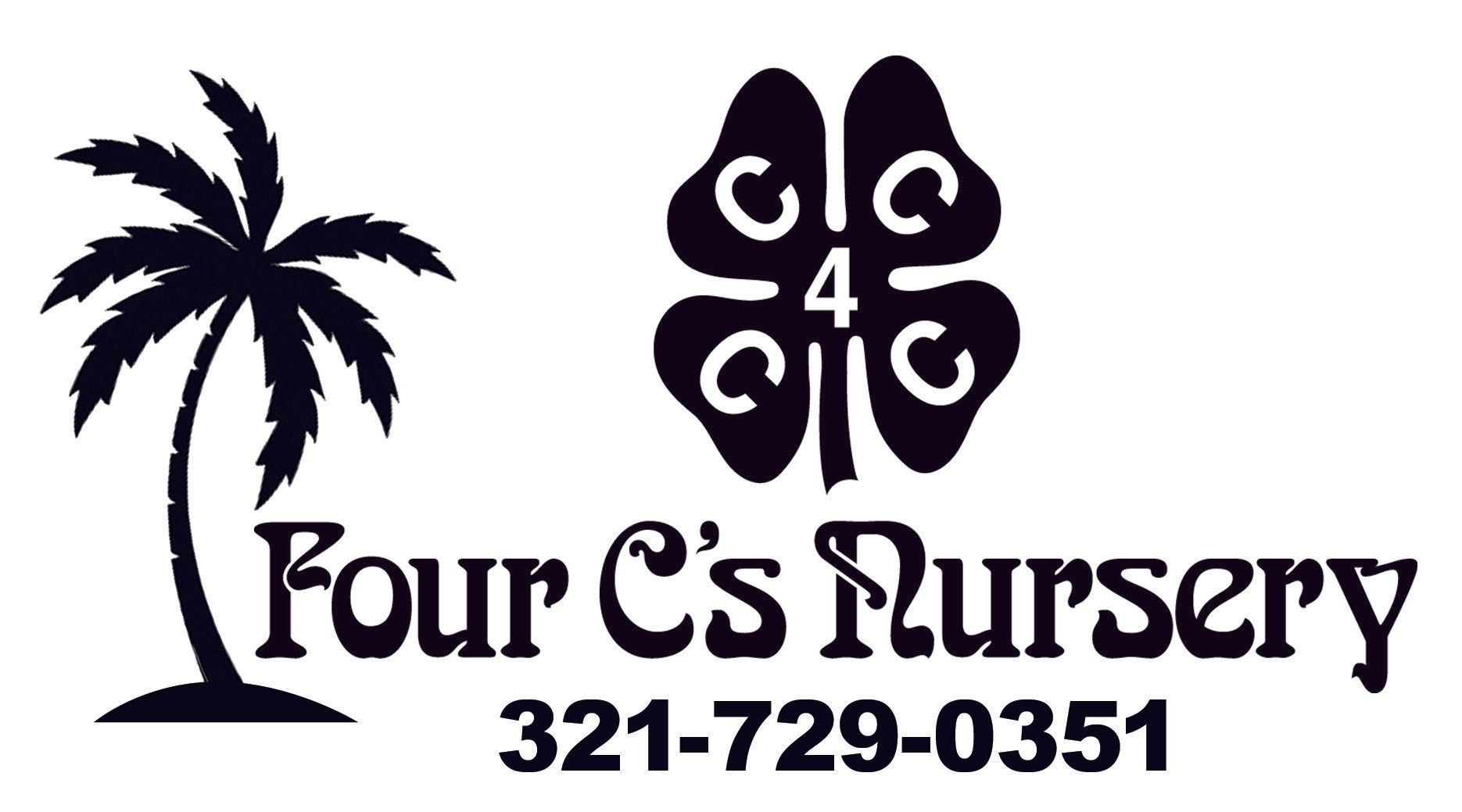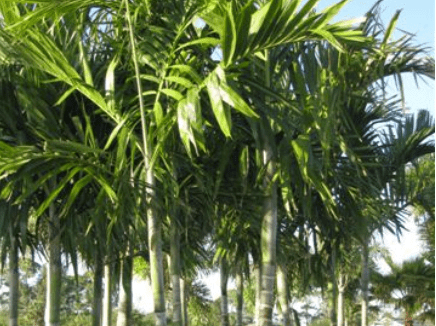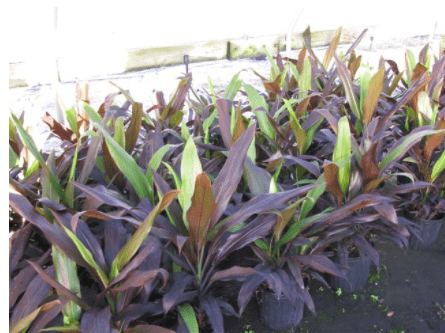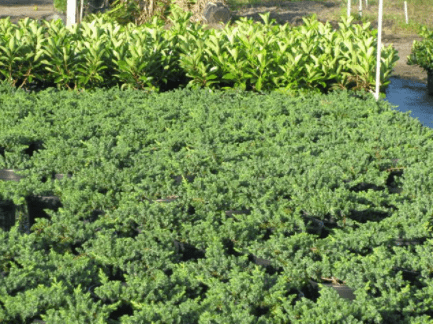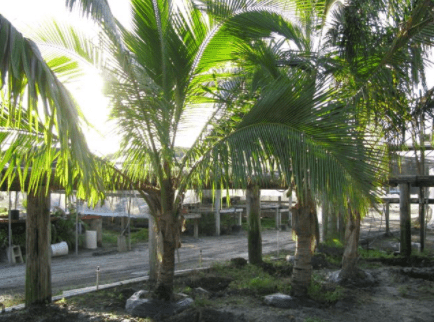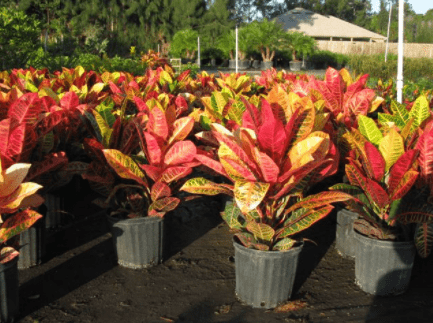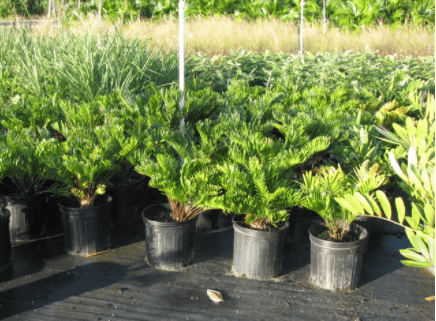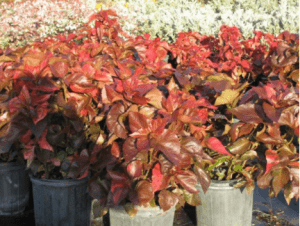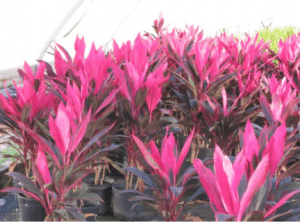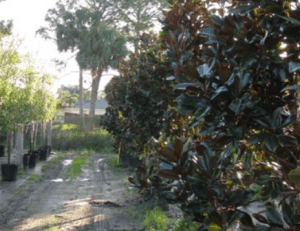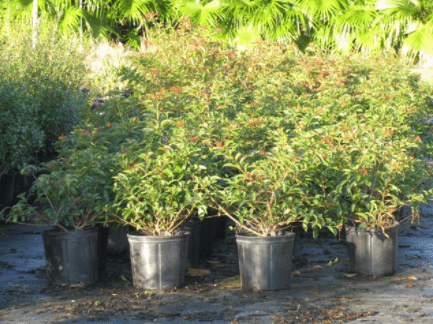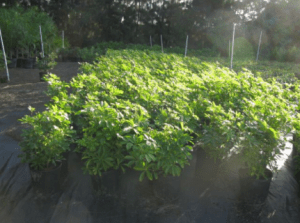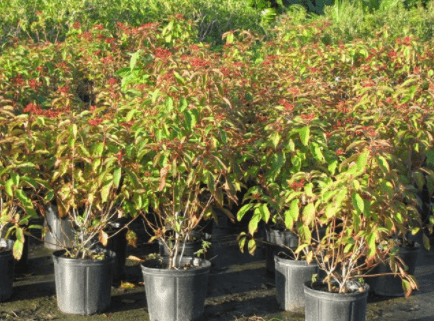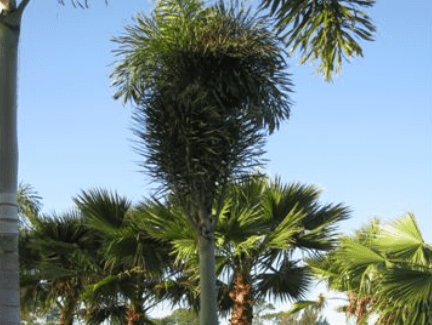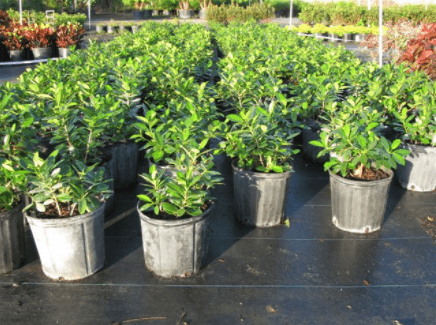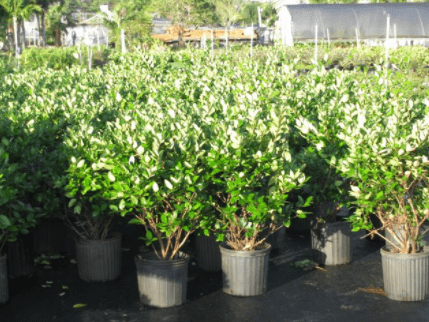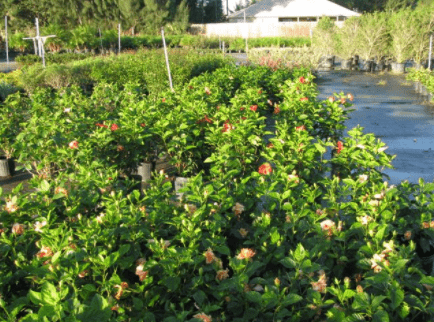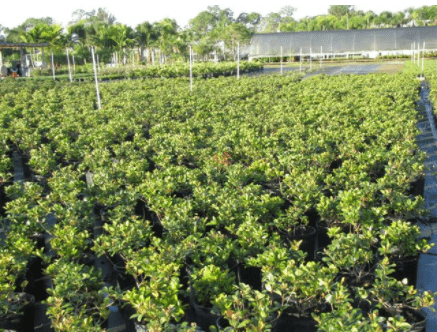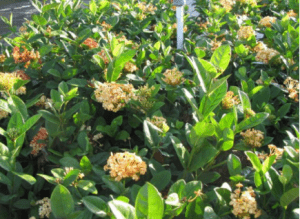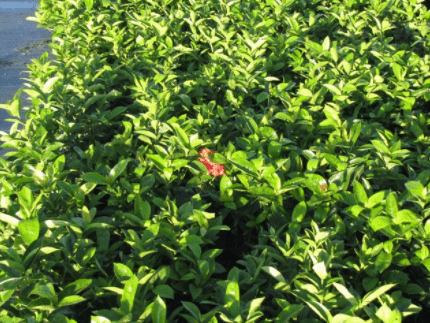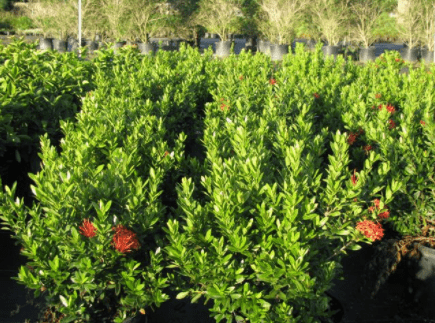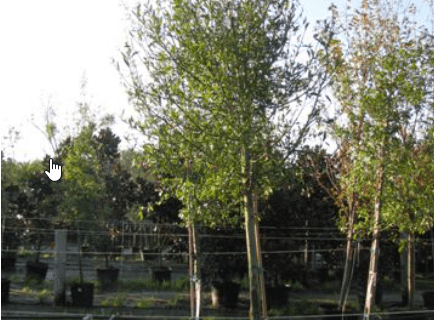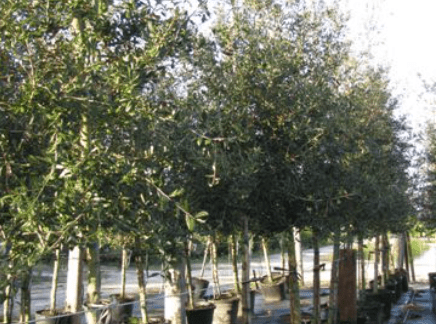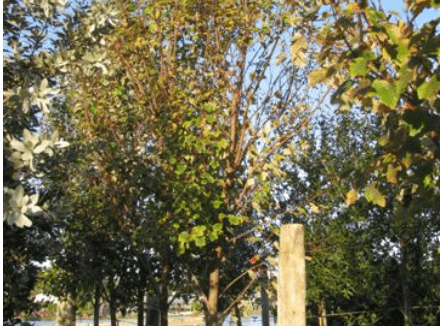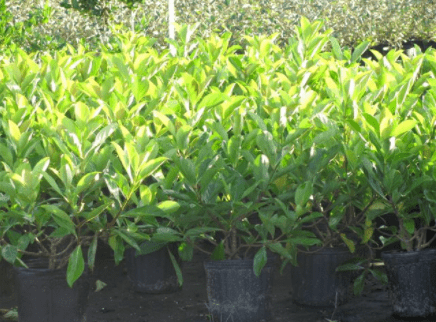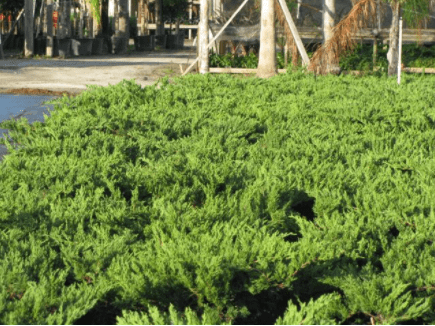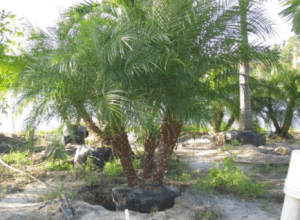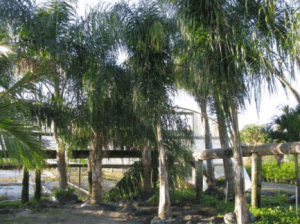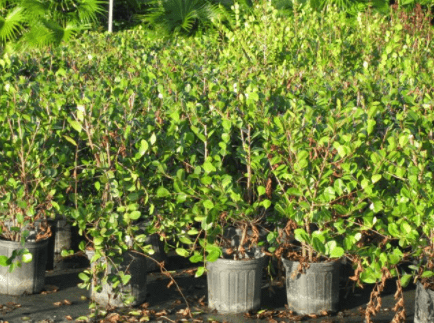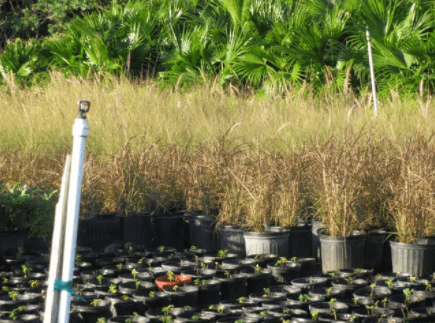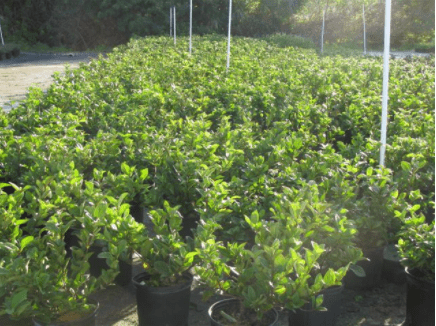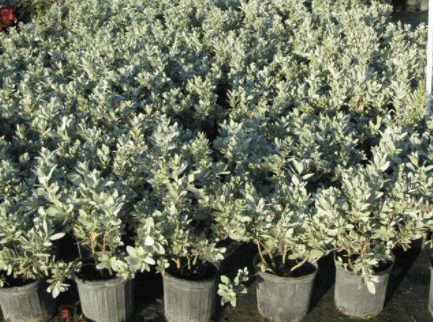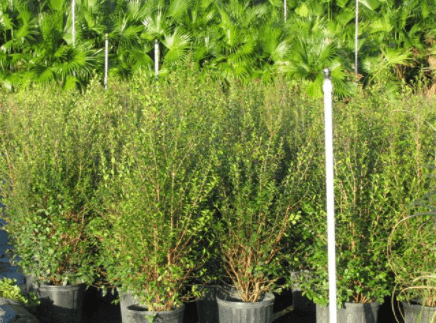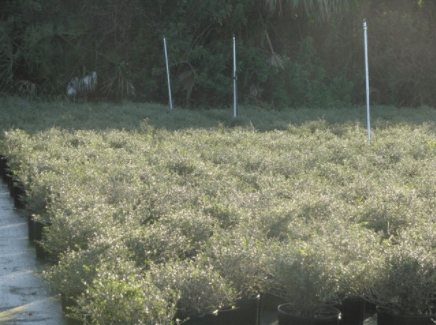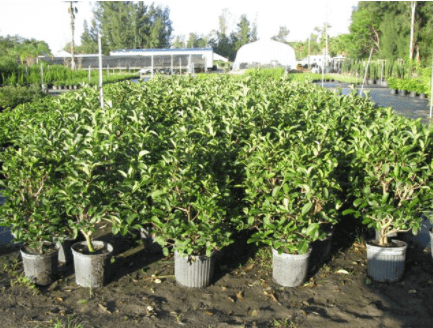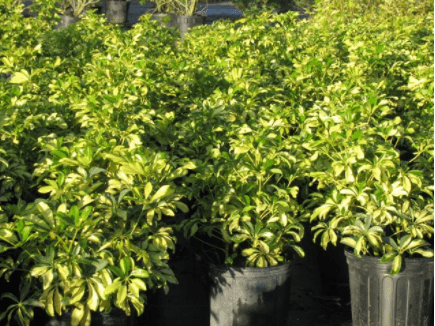Your Unique Wholesale Nursery
We are a wholesale grower offering outdoor perennials, along with ferns, groundcovers, succulents, grasses, xeric plants, and vines. Our extensive list of perennials that are well suited for the Palm Bay area has been developed through years of trial and study. We are located in 242 Alcantarra St. NW Palm Bay, FL 32907.
Products
Our knowledgeable staff can help with your landscape project and provide valuable information about our many plant varieties. If we do not have the item you are looking for, or you have a request for something special, just ask!
Alexander Palm
(Archontophoenix alexandre)
Native to Queensland, Australia.
It grows in littoral rainforest, often in positions that are severely inundated during heavy rain events. Their ability to withstand these conditions allow them to become the dominant species.
- Plant information guide
Category:
Palms
Height:
over 40 ft. (12 m)
Spacing:
10′ – 15′ Apart
Hardiness:
USDA Zone 9b: to -3.8 °C (25 °F)
USDA Zone 10a: to -1.1 °C (30 °F)
USDA Zone 10b: to 1.7 °C (35 °F)
USDA Zone 11: above 4.5 °C (40 °F)
Sun Exposure:
Full Sun
Sun to Partial Shade
Light Shade
Bloom Color:
White/Near White
Bloom Time:
Blooms all year
Foliage:
Grown for foliage
Evergreen
Other details:
Average Water Needs; Water regularly; do not overwater
Soil pH requirements:
6.1 to 6.5 (mildly acidic)
6.6 to 7.5 (neutral)
7.6 to 7.8 (mildly alkaline)
Patent Information:
Non-patented
Propagation Methods:
From seed; germinate in vitro in gelatin, agar or other medium.
‘Black Magic’ Ti
(Cordyline Fruticosa)
Native to tropical southeastern Asia, northeastern Australia , the Indian Ocean, and parts of Polynesia.
It is not native to Hawaii or New Zealand but exists on those islands as a feral weed introduced by Polynesian settlers.
- Plant information guide
Category:
Tropicals and Tender Perennials
Height:
upto 8′ to 10′ if not pruned back
Spacing:
used as accent plants
Hardiness:
USDA Zone 10a: to -1.1 °C (30 °F)
USDA Zone 10b: to 1.7 °C (35 °F)
USDA Zone 11: above 4.5 °C (40 °F)
Sun Exposure:
Partial Sun to Shade
Danger:
N/A
Bloom Color:
Pale Pink
Pink
Bloom Time:
Mid Summer
Foliage:
Grown for foliage
Evergreen
Burgundy
Bronze-Green
Other details:
This plant is suitable for growing indoors
Average Water Needs; Water regularly; do not overwater
Provides winter interest
Suitable for growing in containers
Soil pH requirements:
5.6 to 6.0 (acidic)
6.1 to 6.5 (mildly acidic)
Patent Information:
Non-patented
Propagation Methods:
By dividing rhizomes, tubers, corms or bulbs (including offsets)
From softwood cuttings
By air layering
Seed Collecting:
N/A: plant does not set seed, flowers are sterile, or plants will not come true from seed
Blue Pacific
(Juniperus Conferta)
Widely distributed throughout the northern hemisphere, from the Arctic, south to tropical Africa, and the mountains of Central America.
- Plant information guide
Category:
Groundcovers
Conifers
Height:
6-12 in. (15-30 cm)
Spacing:
2-3 Ft.
Hardiness:
USDA Zone 5a: to -28.8 °C (-20 °F)
USDA Zone 5b: to -26.1 °C (-15 °F)
USDA Zone 6a: to -23.3 °C (-10 °F)
USDA Zone 6b: to -20.5 °C (-5 °F)
USDA Zone 7a: to -17.7 °C (0 °F)
USDA Zone 7b: to -14.9 °C (5 °F)
USDA Zone 8a: to -12.2 °C (10 °F)
USDA Zone 8b: to -9.4 °C (15 °F)
USDA Zone 9a: to -6.6 °C (20 °F)
USDA Zone 9b: to -3.8 °C (25 °F)
Sun Exposure:
Full Sun
Danger:
Pollen may cause allergic reaction
Foliage:
Blue-Green
Other details:
Average Water Needs; Water regularly; do not overwater
Blueberry Flax Lilly
(Dianella Tasmanica)
Native to southeastern Australia and Tasmania.
- Plant information guide
Category:
Tropicals and Tender Perennials
Height:
2 – 3 Ft
Spacing:
2.5 – 3 Ft
Hardiness:
USDA Zone 9b: to -3.8 °C (25 °F)
USDA Zone 10a: to -1.1 °C (30 °F)
USDA Zone 10b: to 1.7 °C (35 °F)
USDA Zone 11: above 4.5 °C (40 °F)
Sun Exposure:
Sun to Partial Shade
Danger:
Parts of plant are poisonous if ingested
Bloom Color:
Medium Blue
Bloom Time:
Mid Spring
Late Spring/Early Summer
Foliage:
Grown for foliage
Evergreen
Variegated
Other details:
Drought-tolerant; suitable for xeriscaping
Average Water Needs; Water regularly; do not overwater
Suitable for growing in containers
Soil pH requirements:
6.1 to 6.5 (mildly acidic)
6.6 to 7.5 (neutral)
Patent Information:
Non-patented
Propagation Methods:
By dividing rhizomes, tubers, corms or bulbs (including offsets)
Seed Collecting:
N/A: plant does not set seed, flowers are sterile, or plants will not come true from seed
Christmas Palm
(Adonidia Merrillii)
It is found naturally growing only in the Phillipines.
Commonly known as the “Christmas Palm” because its fruits become bright scarlet and tend to be that color in winter.
- Plant information guide
Category:
Palms
Height:
upto 20 ft.
Spacing:
10 – 15 ft.
Hardiness:
USDA Zone 10a: to -1.1 °C (30 °F)
USDA Zone 10b: to 1.7 °C (35 °F)
USDA Zone 11: above 4.5 °C (40 °F)
Sun Exposure:
Full Sun
Danger:
N/A
Bloom Color:
Chartreuse (Yellow-Green)
Green
Bloom Time:
Blooms all year
Foliage:
Evergreen
Other details:
Average Water Needs; Water regularly; do not overwater
Soil pH requirements:
6.6 to 7.5 (neutral)
7.9 to 8.5 (alkaline)
Patent Information:
Non-patented
Propagation Methods:
From seed; germinate in vitro in gelatin, agar or other medium.
Coconut Palm
(Cocos Nuifera)
The coconut palm is grown throughout the tropics.
- Plant information guide
Category:
Tropicals and Tender Perennials
Height:
upto 8′ to 10′ if not pruned back
Spacing:
used as accent plants
Hardiness:
USDA Zone 10a: to -1.1 °C (30 °F)
USDA Zone 10b: to 1.7 °C (35 °F)
USDA Zone 11: above 4.5 °C (40 °F)
Sun Exposure:
Partial Sun to Shade
Danger:
N/A
Bloom Color:
Pale Pink
Pink
Bloom Time:
Mid Summer
Foliage:
Grown for foliage
Evergreen
Burgundy
Bronze-Green
Other details:
This plant is suitable for growing indoors
Average Water Needs; Water regularly; do not overwater
Provides winter interest
Suitable for growing in containers
Soil pH requirements:
5.6 to 6.0 (acidic)
6.1 to 6.5 (mildly acidic)
Patent Information:
Non-patented
Propagation Methods:
By dividing rhizomes, tubers, corms or bulbs (including offsets)
From softwood cuttings
By air layering
Seed Collecting:
N/A: plant does not set seed, flowers are sterile, or plants will not come true from seed
Codiaeum Variegatum ‘Petra’
(Codiaeum Variegatum)
Native to southeast Asia.
This plant is also known as a Croton.
- Plant information guide
Category:
Tropicals and Tender Perennials
Height:
4 – 5 Ft
Spacing:
3 – 4 Ft
Hardiness:
USDA Zone 10a: to -1.1 °C (30 °F)
USDA Zone 10b: to 1.7 °C (35 °F)
USDA Zone 11: above 4.5 °C (40 °F)
Sun Exposure:
Sun to Partial Shade
Danger:
All parts of plant are poisonous if ingested
Bloom Color:
Gold (Yellow-Orange)
Bloom Time:
Blooms repeatedly
Foliage:
Grown for foliage
Evergreen
Variegated
Chartreuse/Yellow
Burgundy
Bronze-Green
Smooth-Textured
Veined
Other details:
Requires consistently moist soil; do not let dry out between waterings
This plant is suitable for growing indoors
Soil pH requirements:
6.1 to 6.5 (mildly acidic)
Patent Information:
Non-patented
Propagation Methods:
From woody stem cuttings
From softwood cuttings
From semi-hardwood cuttings
By air layering
By tip layering
By stooling or mound layering
Seed Collecting:
Bag seedheads to capture ripening seed.
Coontie
(Zamia Pumila)
A small, tough, woody shrub native to the southeast United States (FL, GA) and the Caribbean.
- Plant information guide
Category:
Shrubs
Cycads
Height:
3 – 4 Ft
Spacing:
3 – 4 Ft
Hardiness:
USDA Zone 8a: to -12.2 °C (10 °F)
USDA Zone 8b: to -9.4 °C (15 °F)
USDA Zone 9a: to -6.6 °C (20 °F)
USDA Zone 9b: to -3.8 °C (25 °F)
USDA Zone 10a: to -1.1 °C (30 °F)
USDA Zone 10b: to 1.7 °C (35 °F)
Sun Exposure:
Full Sun
Sun to Partial Shade
Light Shade
Bloom Color:
Inconspicuous/none
Foliage:
Grown for foliage
Evergreen
Smooth-Textured
Shiny/Glossy-Textured
Other details:
Drought-tolerant; suitable for xeriscaping
Patent Information:
Non-patented
Propagation Methods:
From seed; direct sow outdoors in fall
Seed Collecting:
Allow seedheads to dry on plants; remove and collect seeds
Seed does not store well; sow as soon as possible
Copperleaf
(Acalypha Wilkesiana)
This plant is mostly tropical to subtropical, distributed mostly from the southern United States to Uruguay.
- Plant information guide
Category:
Tropicals and Tender Perennials
Height:
8 – 10 Ft
Spacing:
3 -4 Ft
Hardiness:
USDA Zone: 9 – 11
Sun Exposure:
Full Sun
Sun to Partial Shade
Danger:
All parts of plant are poisonous if ingested
Bloom Color:
Brown/Bronze
Inconspicuous/none
Bloom Time:
Late Summer/Early Fall
Foliage:
Evergreen
Burgundy
Bronze-Green
Mottled
Veined
Other details:
This plant is suitable for growing indoors
Average Water Needs; Water regularly; do not overwater
Soil pH requirements:
5.6 to 6.0 (acidic)
6.1 to 6.5 (mildly acidic)
6.6 to 7.5 (neutral)
Patent Information:
Non-patented
Propagation Methods:
From herbaceous stem cuttings
Seed Collecting:
N/A: plant does not set seed, flowers are sterile, or plants will not come true from seed
Cordyline Fruticosa ‘Red Sister’ Ti
(Cordyline Fruticosa)
Native to tropical southeastern Asia, northeastern Australia , the Indian Ocean, and parts of Polynesia.
It is not native to Hawaii or New Zealand but exists on those islands as a feral weed introduced by Polynesian settlers.
- Plant information guide
Category:
Tropicals and Tender Perennials
Height:
upto 8 – 10 Ft (if not pruned)
Spacing:
Accent Plant
Hardiness:
USDA Zone 10a: to -1.1 °C (30 °F)
USDA Zone 10b: to 1.7 °C (35 °F)
USDA Zone 11: above 4.5 °C (40 °F)
Sun Exposure:
Full Sun
Sun to Partial Shade
Danger:
N/A
Bloom Color:
Pale Pink
Pink
Bloom Time:
Mid Summer
Foliage:
Grown for foliage
Evergreen
Burgundy
Bronze-Green
Other details:
This plant is suitable for growing indoors
Average Water Needs; Water regularly; do not overwater
Provides winter interest
Suitable for growing in containers
Soil pH requirements:
5.6 to 6.0 (acidic)
6.1 to 6.5 (mildly acidic)
Patent Information:
Non-patented
Propagation Methods:
By dividing rhizomes, tubers, corms or bulbs (including offsets)
From softwood cuttings
By air layering
Seed Collecting:
N/A: plant does not set seed, flowers are sterile, or plants will not come true from seed
D.D. Blanchard
(Magnolia Grandiflora)
Also known as the Southern Magnolia, this tree is native to the Southeastern United States.
- Plant information guide
Category:
Trees
Height:
80 – 100 Ft
Spacing:
15 – 20 Ft
Hardiness:
USDA Zone 6a: to -23.3 °C (-10 °F)
USDA Zone 6b: to -20.5 °C (-5 °F)
USDA Zone 7a: to -17.7 °C (0 °F)
USDA Zone 7b: to -14.9 °C (5 °F)
USDA Zone 8a: to -12.2 °C (10 °F)
USDA Zone 8b: to -9.4 °C (15 °F)
USDA Zone 9a: to -6.6 °C (20 °F)
USDA Zone 9b: to -3.8 °C (25 °F)
USDA Zone 10a: to -1.1 °C (30 °F)
USDA Zone 10b: to 1.7 °C (35 °F)
Sun Exposure:
Sun to Partial Shade
Bloom Color:
White/Near White
Bloom Time:
Mid Spring
Late Spring/Early Summer
Mid Summer
Late Summer/Early Fall
Mid Fall
Blooms repeatedly
Foliage:
Grown for foliage
Evergreen
Smooth-Textured
Other details:
Flowers are fragrant
Average Water Needs; Water regularly; do not overwater
Soil pH requirements:
6.1 to 6.5 (mildly acidic)
6.6 to 7.5 (neutral)
Seed Collecting:
N/A: plant does not set seed, flowers are sterile, or plants will not come true from seed
Dwarf Firebush
(Hamelia Patens ‘Compacta’)
Native to the American subtropics and tropics. Its range extends from Florida to as far south as Argentina.
- Plant information guide
Category:
Tropicals and Tender Perennials
Height:
4 -6 Ft
Spacing:
3 – 4 Ft
Hardiness:
USDA Zone 9b: to -3.8 °C (25 °F)
USDA Zone 10a: to -1.1 °C (30 °F)
USDA Zone 10b: to 1.7 °C (35 °F)
USDA Zone 11: above 4.5 °C (40 °F)
Sun Exposure:
Full Sun
Bloom Color:
Red-Orange
Bloom Time:
Late Spring/Early Summer
Mid Summer
Late Summer/Early Fall
Mid Fall
Late Fall/Early Winter
Foliage:
Grown for foliage
Evergreen
Other details:
This plant is attractive to bees, butterflies and/or birds
Average Water Needs; Water regularly; do not overwater
Provides winter interest
Soil pH requirements:
6.1 to 6.5 (mildly acidic)
6.6 to 7.5 (neutral)
7.6 to 7.8 (mildly alkaline)
Patent Information:
Non-patented
Propagation Methods:
From seed; direct sow outdoors in fall
Seed Collecting:
Allow seedheads to dry on plants; remove and collect seeds
Dwarf Schefflera
(Schefflera Arboricola)
Native to Taiwan and Hainan.
- Plant information guide
Category:
Tropicals and Tender Perennials
Height:
10-12 Ft
Spacing:
3-4 Ft
Hardiness:
USDA Zone: 9 – 11
Sun Exposure:
Sun to Partial Shade
Light Shade
Partial to Full Shade
Bloom Color:
Red
Brown/Bronze
Bloom Time:
Late Spring/Early Summer
Mid Summer
Foliage:
Evergreen
Variegated
Other details:
Average Water Needs; Water regularly; do not overwater
Soil pH requirements:
6.1 to 6.5 (mildly acidic)
6.6 to 7.5 (neutral)
7.6 to 7.8 (mildly alkaline)
Patent Information:
Patented
European Fan Palm
(Chamaerops Humilis)
This palm is native to the western Mediterranean region, and mainly found in southwestern Europe.
- Plant information guide
Category:
Palms
Height:
12-15 ft. (3.6-4.7 m)
Spacing:
8-10 ft. (2.4-3 m)
Hardiness:
USDA Zone 8a: to -12.2 °C (10 °F)
USDA Zone 8b: to -9.4 °C (15 °F)
USDA Zone 9a: to -6.6 °C (20 °F)
USDA Zone 9b: to -3.8 °C (25 °F)
USDA Zone 10a: to -1.1 °C (30 °F)
USDA Zone 10b: to 1.7 °C (35 °F)
USDA Zone 11: above 4.5 °C (40 °F)
Sun Exposure:
Sun to Partial Shade
Light Shade
Danger:
Plant has spines or sharp edges; use extreme caution when handling
Foliage:
Grown for foliage
Evergreen
Variegated
Other details:
Drought-tolerant; suitable for xeriscaping
Average Water Needs; Water regularly; do not overwater
Soil pH requirements:
6.1 to 6.5 (mildly acidic)
6.6 to 7.5 (neutral)
7.6 to 7.8 (mildly alkaline)
Patent Information:
Non-patented
Propagation Methods:
From seed; germinate in vitro in gelatin, agar or other medium
Firebush
(Hamelia Patens)
Native to the America subtropics and tropics. Its range extends from Florida to as far south as Argentina.
- Plant information guide
Category:
Tropicals and Tender Perennials
Height:
10-12 Ft
Spacing:
3-4 Ft
Hardiness:
USDA Zone 9a: to -6.6 °C (20 °F)
USDA Zone 9b: to -3.8 °C (25 °F)
USDA Zone 10a: to -1.1 °C (30 °F)
USDA Zone 10b: to 1.7 °C (35 °F)
USDA Zone 11: above 4.5 °C (40 °F)
Sun Exposure:
Full Sun
Bloom Color:
Red-Orange
Bloom Time:
Late Spring/Early Summer
Mid Summer
Late Summer/Early Fall
Mid Fall
Late Fall/Early Winter
Foliage:
Grown for foliage
Evergreen
Other details:
This plant is attractive to bees, butterflies and/or birds
Average Water Needs; Water regularly; do not overwater
Provides winter interest
Soil pH requirements:
6.1 to 6.5 (mildly acidic)
6.6 to 7.5 (neutral)
7.6 to 7.8 (mildly alkaline)
Patent Information:
Non-patented
Propagation Methods:
From seed; direct sow outdoors in fall
Foxtail Palm
(Wodyetia Bifurcata)
The Foxtail Palm is endemic to a very small part of Australia.
- Plant information guide
Category:
Tropicals and Tender Perennials
Palms
Height:
30 Ft
Spacing:
10-12 ft. (3-3.6 m)
Hardiness:
USDA Zone 9b: to -3.8 °C (25 °F)
USDA Zone 10a: to -1.1 °C (30 °F)
USDA Zone 10b: to 1.7 °C (35 °F)
USDA Zone 11: above 4.5 °C (40 °F)
Sun Exposure:
Full Sun
Sun to Partial Shade
Danger:
Seed is poisonous if ingested
Bloom Color:
White/Near White
Foliage:
Evergreen
Other details:
Average Water Needs; Water regularly; do not overwater
Requires consistently moist soil; do not let dry out between waterings
Soil pH requirements:
5.6 to 6.0 (acidic)
6.1 to 6.5 (mildly acidic)
6.6 to 7.5 (neutral)
7.6 to 7.8 (mildly alkaline)
Propagation Methods:
From seed; direct sow outdoors in fall
Green Island Ficus
(Ficus Macrocarpa ‘Green Island’)
Native in the range from Sri Lanka to India, southern China to Australia.
- Plant information guide
Category:
Shrub
Height:
Spacing:
2.5′ to 3′ Ft
Hardiness:
USDA Zone 9b: to -3.8 °C (25 °F)
USDA Zone 10a: to -1.1 °C (30 °F)
USDA Zone 10b: to 1.7 °C (35 °F)
USDA Zone 11: above 4.5 °C (40 °F)
Sun Exposure:
Full Sun
Danger:
Parts of plant are poisonous if ingested
Handling plant may cause skin irritation or allergic reaction
Bloom Color:
Inconspicuous/none
Foliage:
Grown for foliage
Evergreen
Shiny/Glossy-Textured
Other details:
May be a noxious weed
This plant is attractive to bees, butterflies and/or birds
Average Water Needs; Water regularly; do not overwater
Self-sows freely; deadhead if you do not want volunteer seedlings next season
Propagation Methods:
From woody stem cuttings
Green Ligustrum
(Ligustrum Lucidum)
Native to the southern half of China and is classed as a noxious weed in Austrailia where it was introduced.
- Plant information guide
Category:
Shrubs
Trees
Height:
15-20 Ft
Spacing:
3-4 Ft
Hardiness:
USDA Zone 8a: to -12.2 °C (10 °F)
USDA Zone 8b: to -9.4 °C (15 °F)
USDA Zone 9a: to -6.6 °C (20 °F)
USDA Zone 9b: to -3.8 °C (25 °F)
USDA Zone 10a: to -1.1 °C (30 °F)
USDA Zone 10b: to 1.7 °C (35 °F)
Sun Exposure:
Full Sun
Sun to Partial Shade
Danger:
Parts of plant are poisonous if ingested
Bloom Color:
White/Near White
Bloom Time:
Mid Spring
Late Spring/Early Summer
Foliage:
Grown for foliage
Evergreen
Shiny/Glossy-Textured
Other details:
Average Water Needs; Water regularly; do not overwater
Suitable for growing in containers
Soil pH requirements:
6.1 to 6.5 (mildly acidic)
6.6 to 7.5 (neutral)
7.6 to 7.8 (mildly alkaline)
Propagation Methods:
From seed; direct sow after last frost
Seed Collecting:
Bag seedheads to capture ripening seed
Properly cleaned, seed can be successfully stored
Hibiscus
Native to warm, temperate, subtropical and tropical regions throughout the world.
- Plant information guide
Category:
Perennials
Shrubs
Trees
Tropicals and Tender Perennials
Hardiness:
USDA Zone 9b: to -3.8 °C (25 °F)
USDA Zone 10a: to -1.1 °C (30 °F)
USDA Zone 10b: to 1.7 °C (35 °F)
USDA Zone 11: above 4.5 °C (40 °F)
Sun Exposure:
Sun to Partial Shade
Light Shade
Partial to Full Shade
Bloom Color:
Fuchsia (Red-Purple)
Red
Scarlet (Dark Red)
Orange
Red-Orange
Gold (Yellow-Orange)
Bright Yellow
Foliage:
Grown for foliage
Evergreen
Deciduous
Burgundy
Dark/Black
Bronze-Green
Smooth-Textured
Shiny/Glossy-Textured
Leathery-Textured
Other details:
May be a noxious weed or invasive
This plant is attractive to bees, butterflies and/or birds
Flowers are fragrant
Average Water Needs; Water regularly; do not overwater
Requires consistently moist soil; do not let dry out between waterings
Indian Hawthorne
(Rhaphiolepis Indica)
The species is from southern China.
- Plant information guide
Category:
Shrubs
Height:
4-5 Ft
Spacing:
2.5-3 Ft
Hardiness:
USDA Zone 6a: to -23.3 °C (-10 °F)
USDA Zone 6b: to -20.5 °C (-5 °F)
USDA Zone 7a: to -17.7 °C (0 °F)
USDA Zone 7b: to -14.9 °C (5 °F)
USDA Zone 8a: to -12.2 °C (10 °F)
USDA Zone 8b: to -9.4 °C (15 °F)
USDA Zone 9a: to -6.6 °C (20 °F)
USDA Zone 9b: to -3.8 °C (25 °F)
USDA Zone 10a: to -1.1 °C (30 °F)
USDA Zone 10b: to 1.7 °C (35 °F)
Sun Exposure:
Full Sun
Bloom Color:
Pale Pink
Bloom Time:
Late Spring/Early Summer
Late Summer/Early Fall
Foliage:
Grown for foliage
Evergreen
Other details:
This plant is attractive to bees, butterflies and/or birds
Flowers are fragrant
Soil pH requirements:
over 9.1 (very alkaline)
Propagation Methods:
From semi-hardwood cuttings
Ixora ‘Maui Yellow’
Native to tropical areas in Asia, especially India, ixora now grows commonly in tropical climates in the USA, such as Florida.
- Plant information guide
Category:
Annuals
Perennials
Tropicals and Tender Perennials
Height:
6-8 Ft
Spacing:
3 Ft
Hardiness:
USDA Zone 9a: to -6.6 °C (20 °F)
USDA Zone 9b: to -3.8 °C (25 °F)
USDA Zone 10a: to -1.1 °C (30 °F)
USDA Zone 10b: to 1.7 °C (35 °F)
USDA Zone 11: above 4.5 °C (40 °F)
Sun Exposure:
Full Sun
Sun to Partial Shade
Danger:
N/A
Bloom Color:
Bright Yellow
Bloom Time:
Late Spring/Early Summer
Mid Summer
Late Summer/Early Fall
Foliage:
Evergreen
Soil pH requirements:
5.6 to 6.0 (acidic)
Propagation Methods:
From woody stem cuttings
Seed Collecting:
Allow unblemished fruit to ripen; clean and dry seeds
Ixora ‘Maui’
Native to tropical areas in Asia, especially India, ixora now grows commonly in tropical climates in the USA, such as Florida.
- Plant information guide
Category:
Annuals
Perennials
Tropicals and Tender Perennials
Height:
6-8 Ft
Spacing:
3 Ft
Hardiness:
USDA Zone 9a: to -6.6 °C (20 °F)
USDA Zone 9b: to -3.8 °C (25 °F)
USDA Zone 10a: to -1.1 °C (30 °F)
USDA Zone 10b: to 1.7 °C (35 °F)
USDA Zone 11: above 4.5 °C (40 °F)
Sun Exposure:
Full Sun
Sun to Partial Shade
Danger:
N/A
Bloom Color:
Red
Bloom Time:
Late Spring/Early Summer
Mid Summer
Late Summer/Early Fall
Foliage:
Evergreen
Soil pH requirements:
5.6 to 6.0 (acidic)
Propagation Methods:
From woody stem cuttings
Seed Collecting:
Allow unblemished fruit to ripen; clean and dry seeds
Seed Collecting:
Bag seedheads to capture ripening seed
Properly cleaned, seed can be successfully stored
Ixora ‘Nora Grant’
Native to tropical areas in Asia, especially India, ixora now grows commonly in tropical climates in the USA, such as Florida.
- Plant information guide
Category:
Annuals
Perennials
Tropicals and Tender Perennials
Height:
6-8 Ft
Spacing:
3 Ft
Hardiness:
USDA Zone 9a: to -6.6 °C (20 °F)
USDA Zone 9b: to -3.8 °C (25 °F)
USDA Zone 10a: to -1.1 °C (30 °F)
USDA Zone 10b: to 1.7 °C (35 °F)
USDA Zone 11: above 4.5 °C (40 °F)
Sun Exposure:
Full Sun
Sun to Partial Shade
Danger:
N/A
Bloom Color:
Red
Bloom Time:
Late Spring/Early Summer
Mid Summer
Late Summer/Early Fall
Foliage:
Evergreen
Soil pH requirements:
5.6 to 6.0 (acidic)
Propagation Methods:
From woody stem cuttings
Seed Collecting:
Allow unblemished fruit to ripen; clean and dry seeds
Ixora ‘Petite’
Native to tropical areas in Asia, especially India, ixora now grows commonly in tropical climates in the USA, such as Florida.
- Plant information guide
Category:
Annuals
Perennials
Tropicals and Tender Perennials
Height:
3-4 Ft
Spacing:
2.5-3 Ft
Hardiness:
USDA Zone 9a: to -6.6 °C (20 °F)
USDA Zone 9b: to -3.8 °C (25 °F)
USDA Zone 10a: to -1.1 °C (30 °F)
USDA Zone 10b: to 1.7 °C (35 °F)
USDA Zone 11: above 4.5 °C (40 °F)
Sun Exposure:
Full Sun
Sun to Partial Shade
Danger:
N/A
Bloom Color:
Many
Bloom Time:
Late Spring/Early Summer
Mid Summer
Late Summer/Early Fall
Foliage:
Evergreen
Soil pH requirements:
5.6 to 6.0 (acidic)
Propagation Methods:
From woody stem cuttings
Seed Collecting:
Allow unblemished fruit to ripen; clean and dry seeds
Laurel Oak
(Quercus Laurifolia)
Native to the southeast United States.
- Plant information guide
Category:
Trees
Height:
60-80 Ft
Spacing:
20 Ft
Hardiness:
USDA Zone 6a: to -23.3 °C (-10 °F)
USDA Zone 6b: to -20.5 °C (-5 °F)
USDA Zone 7a: to -17.7 °C (0 °F)
USDA Zone 7b: to -14.9 °C (5 °F)
USDA Zone 8a: to -12.2 °C (10 °F)
USDA Zone 8b: to -9.4 °C (15 °F)
USDA Zone 9a: to -6.6 °C (20 °F)
USDA Zone 9b: to -3.8 °C (25 °F)
Sun Exposure:
Full Sun
Bloom Color:
Inconspicuous/none
Bloom Time:
Mid Spring
Foliage:
Grown for foliage
Deciduous
Shiny/Glossy-Textured
Other details:
Average Water Needs; Water regularly; do not overwater
Propagation Methods:
From seed; direct sow outdoors in fall
Live Oak
(Quercus Virginiana)
Native to the southeast United States.
- Plant information guide
Category:
Trees
Height:
40-60 Ft
Spacing:
20 Ft
Hardiness:
USDA Zone 8a: to -12.2 °C (10 °F)
USDA Zone 8b: to -9.4 °C (15 °F)
USDA Zone 9a: to -6.6 °C (20 °F)
USDA Zone 9b: to -3.8 °C (25 °F)
USDA Zone 10a: to -1.1 °C (30 °F)
USDA Zone 10b: to 1.7 °C (35 °F)
USDA Zone 11: above 4.5 °C (40 °F)
Sun Exposure:
Sun to Partial Shade
Danger:
Parts of plant are poisonous if ingested
Bloom Color:
Cream/Tan
Bloom Time:
Mid Spring
Foliage:
Evergreen
Herbaceous
Smooth-Textured
Other details:
Average Water Needs; Water regularly; do not overwater
Soil pH requirements:
5.1 to 5.5 (strongly acidic)
5.6 to 6.0 (acidic)
6.1 to 6.5 (mildly acidic)
6.6 to 7.5 (neutral)
Patent Information:
Non-patented
Propagation Methods:
From seed; direct sow outdoors in fall
Seed Collecting:
Seed does not store well; sow as soon as possible
Maki
(Podocarpus Macrophyllus)
Native to southern Japan and southern China.
- Plant information guide
Category:
Conifers
Height:
20-30 ft. (6-9 m)
Spacing:
2.5-3 Ft
Hardiness:
USDA Zone 8a: to -12.2 °C (10 °F)
USDA Zone 8b: to -9.4 °C (15 °F)
USDA Zone 9a: to -6.6 °C (20 °F)
USDA Zone 9b: to -3.8 °C (25 °F)
USDA Zone 10a: to -1.1 °C (30 °F)
USDA Zone 10b: to 1.7 °C (35 °F)
USDA Zone 11: above 4.5 °C (40 °F)
Sun Exposure:
Sun to Partial Shade
Light Shade
Partial to Full Shade
Danger:
Seed is poisonous if ingested
Parts of plant are poisonous if ingested
Bloom Color:
White/Near White
Bloom Time:
Late Spring/Early Summer
Mid Summer
Foliage:
Grown for foliage
Evergreen
Smooth-Textured
Other details:
Average Water Needs; Water regularly; do not overwater
Propagation Methods:
From hardwood cuttings
From seed; direct sow after last frost
Seed Collecting:
Remove fleshy coating on seeds before storing
Wear gloves to protect hands when handling seeds
Red Maple
(Acer Rubrum)
This is one of the most common and widespread deciduous trees of eastern North America.
- Plant information guide
Category:
Trees
Height:
40-60 Ft
Spacing:
20 Ft
Hardiness:
USDA Zone 4a: to -34.4 °C (-30 °F)
USDA Zone 4b: to -31.6 °C (-25 °F)
USDA Zone 5a: to -28.8 °C (-20 °F)
USDA Zone 5b: to -26.1 °C (-15 °F)
USDA Zone 6a: to -23.3 °C (-10 °F)
USDA Zone 6b: to -20.5 °C (-5 °F)
USDA Zone 7a: to -17.7 °C (0 °F)
USDA Zone 7b: to -14.9 °C (5 °F)
USDA Zone 8a: to -12.2 °C (10 °F)
USDA Zone 8b: to -9.4 °C (15 °F)
USDA Zone 9a: to -6.6 °C (20 °F)
USDA Zone 9b: to -3.8 °C (25 °F)
Sun Exposure:
Sun to Partial Shade
Danger:
N/A
Bloom Color:
Red
Bloom Time:
Mid Spring
Foliage:
Deciduous
Other details:
Average Water Needs; Water regularly; do not overwater
Soil pH requirements:
6.1 to 6.5 (mildly acidic)
6.6 to 7.5 (neutral)
7.6 to 7.8 (mildly alkaline)
Patent Information:
Non-patented
Propagation Methods:
From woody stem cuttings
From softwood cuttings
From semi-hardwood cuttings
From seed; direct sow outdoors in fall
By air layering
Seed Collecting:
Collect seedhead/pod when flowers fade; allow to dry
Seed does not store well; sow as soon as possible
Mirror Leaf Viburnum
(Viburnum Odoratissimum Awabuki )
They are native throughout the temperate Northern Hemisphere, with a few species extending into tropical montane regions in South America and southeast Asia.
- Plant information guide
Category:
Shrubs
Height:
15 – 20 Ft
Spacing:
3-4 Ft
Hardiness:
USDA Zone 9a: to -6.6 °C (20 °F)
USDA Zone 9b: to -3.8 °C (25 °F)
USDA Zone 10a: to -1.1 °C (30 °F)
USDA Zone 10b: to 1.7 °C (35 °F)
USDA Zone 11: above 4.5 °C (40 °F)
Sun Exposure:
Sun to Partial Shade
Light Shade
Bloom Color:
White/Near White
Bloom Time:
Mid Spring
Late Spring/Early Summer
Mid Summer
Late Summer/Early Fall
Mid Fall
Foliage:
Evergreen
Other details:
This plant is attractive to bees, butterflies and/or birds
Average Water Needs; Water regularly; do not overwater
Requires consistently moist soil; do not let dry out between waterings
Provides winter interest
Soil pH requirements:
5.6 to 6.0 (acidic)
6.1 to 6.5 (mildly acidic)
6.6 to 7.5 (neutral)
Propagation Methods:
From semi-hardwood cuttings
Seed Collecting:
N/A: plant does not set seed, flowers are sterile, or plants will not come true from seed
Necklace Pod
(Sophora Tomentosa)
The species are native to southeast Euorpe, southern Asia, Austrialia, the islands of the Pacific Ocean and western Sotuh America.
- Plant information guide
Category:
Shrubs
Tropicals and Tender Perennials
Height:
6-10 Ft
Spacing:
2.5-3 Ft
Hardiness:
USDA Zone 10a
USDA Zone 10b: to 1.7 °C (35 °F)
USDA Zone 11: above 4.5 °C (40 °F)
Sun Exposure:
Full Sun
Sun to Partial Shade
Bloom Color:
Bright Yellow
Bloom Time:
Blooms repeatedly
Foliage:
Silver/Gray
Smooth-Textured
Other details:
This plant is attractive to bees, butterflies and/or birds
Average Water Needs; Water regularly; do not overwater
Soil pH requirements:
6.1 to 6.5 (mildly acidic)
6.6 to 7.5 (neutral)
7.6 to 7.8 (mildly alkaline)
Propagation Methods:
Direct sow as soon as the ground can be worked
Seed Collecting:
Allow pods to dry on plant; break open to collect seeds
Parsonii
(Juniperus Chinensis)
It is native to northeast Asia, in China, Mongolia, Japan, Korea and the southeast of Russia.
- Plant information guide
Category:
Shrubs
Height:
3-4 Ft
Spacing:
2.5-3 Ft
Hardiness:
USDA Zone 4a to 11
Sun Exposure:
Full Sun
Sun to Partial Shade
Danger:
Handling plant may cause skin irritation or allergic reaction
Bloom Color:
Inconspicuous/none
Bloom Time:
N/A
Foliage:
Evergreen
Other details:
This plant is attractive to bees, butterflies and/or birds
Average Water Needs; Water regularly; do not overwater
Provides winter interest
Soil pH requirements:
6.1 to 6.5 (mildly acidic)
6.6 to 7.5 (neutral)
Propagation Methods:
By grafting
Seed Collecting:
N/A: plant does not set seed, flowers are sterile, or plants will not come true from seed
Pygmy Date Palm
(Phoenix Roebelenii)
Native to southeastern Asia from southwestern China to northern Laos and northern Vietnam.
- Plant information guide
Category:
Palms
Height:
10-12 ft. (3-3.6 m)
Hardiness:
USDA Zone 9b: to -3.8 °C (25 °F)
USDA Zone 10a: to -1.1 °C (30 °F)
USDA Zone 10b: to 1.7 °C (35 °F)
USDA Zone 11: above 4.5 °C (40 °F)
Sun Exposure:
Full Sun
Sun to Partial Shade
Foliage:
Evergreen
Other details:
Average Water Needs; Water regularly; do not overwater
Suitable for growing in containers
Queen Palm
(Syagrus Romanzoffiana)
Native to South America, from northern Argentina north to eastern Brazil and west to eastern Bolivia.
- Plant information guide
Category:
Tropicals and Tender Perennials
Palms
Height:
over 40 ft. (12 m)
Spacing:
20-30 ft. (6-9 m)
Hardiness:
USDA Zone 8a: to -12.2 °C (10 °F)
USDA Zone 9a: to -6.6 °C (20 °F)
USDA Zone 9b: to -3.8 °C (25 °F)
USDA Zone 10a: to -1.1 °C (30 °F)
USDA Zone 10b: to 1.7 °C (35 °F)
USDA Zone 11: above 4.5 °C (40 °F)
Sun Exposure:
Full Sun
Bloom Color:
Orange
White/Near White
Bloom Time:
Late Spring/Early Summer
Foliage:
Evergreen
Other details:
Average Water Needs; Water regularly; do not overwater
Soil pH requirements:
6.1 to 6.5 (mildly acidic)
6.6 to 7.5 (neutral)
Patent Information:
Non-patented
Propagation Methods:
From seed; direct sow outdoors in fall
From seed; winter sow in vented containers, coldframe or unheated greenhouse
From seed; direct sow after last frost
Seed Collecting:
Remove fleshy coating on seeds before storing
Seed does not store well; sow as soon as possible
Red Tip Cocoplum
(Chrysobalanus Icaco)
Native to sea beaches and inland throughout tropical America and the Caribbean, including southern Florida.
- Plant information guide
Category:
Perennials
Shrubs
Tropicals and Tender Perennials
Height:
8-10 ft. (2.4-3 m)
Spacing:
3-4 Ft
Hardiness:
USDA Zone 9b: to -3.8 °C (25 °F)
USDA Zone 10a: to -1.1 °C (30 °F)
USDA Zone 10b: to 1.7 °C (35 °F)
USDA Zone 11: above 4.5 °C (40 °F)
Sun Exposure:
Full Sun
Sun to Partial Shade
Bloom Color:
White/Near White
Bloom Time:
Blooms repeatedly
Foliage:
Evergreen
Bronze-Green
Smooth-Textured
Shiny/Glossy-Textured
Leathery-Textured
Other details:
Drought-tolerant; suitable for xeriscaping
Propagation Methods:
From herbaceous stem cuttings
From woody stem cuttings
From semi-hardwood cuttings
From seed; direct sow outdoors in fall
By simple layering
By air layering
Rubrum & Albe
(Pennisetum Setaceum)
Native to open, scrubby habitats in East Africa, tropical Africa, Middle East and southwestern Asia.
- Plant information guide
Category:
Ornamental Grasses and Bamboo
Height:
3-4 Ft
Spacing:
2.5-3 Ft
Hardiness:
USDA Zone 9a: to -6.6 °C (20 °F)
USDA Zone 9b: to -3.8 °C (25 °F)
USDA Zone 10a: to -1.1 °C (30 °F)
USDA Zone 10b: to 1.7 °C (35 °F)
USDA Zone 11: above 4.5 °C (40 °F)
Sun Exposure:
Full Sun
Sun to Partial Shade
Bloom Color:
Red
Purple
Dark Purple/Black
Maroon (Purple-Brown)
Bloom Time:
Late Spring/Early Summer
Mid Summer
Late Summer/Early Fall
Mid Fall
Foliage:
Grown for foliage
Herbaceous
Burgundy
Other details:
Drought-tolerant; suitable for xeriscaping
Average Water Needs; Water regularly; do not overwater
Provides winter interest
Soil pH requirements:
6.6 to 7.5 (neutral)
Patent Information:
Non-patented
Propagation Methods:
By dividing the rootball
Seed Collecting:
N/A: plant does not set seed, flowers are sterile, or plants will not come true from seed
Sandankwa Viburnum
(Viburnum Suspensum)
They are native throughout the temperate Northern Hemishpere, with a few species extending into tropical montane regions in South America and southeast Asia.
- Plant information guide
Category:
Shrubs
Height:
8-12 Ft
Spacing:
2.5-3 Ft
Hardiness:
USDA Zone 8a: to -12.2 °C (10 °F)
USDA Zone 8b: to -9.4 °C (15 °F)
USDA Zone 9a: to -6.6 °C (20 °F)
USDA Zone 9b: to -3.8 °C (25 °F)
USDA Zone 10a: to -1.1 °C (30 °F)
USDA Zone 10b: to 1.7 °C (35 °F)
USDA Zone 11: above 4.5 °C (40 °F)
Sun Exposure:
Sun to Partial Shade
Light Shade
Partial to Full Shade
Bloom Color:
Pale Pink
White/Near White
Bloom Time:
Mid Spring
Late Spring/Early Summer
Foliage:
Evergreen
Other details:
This plant is attractive to bees, butterflies and/or birds
Requires consistently moist soil; do not let dry out between waterings
Provides winter interest
Soil pH requirements:
5.6 to 6.0 (acidic)
6.1 to 6.5 (mildly acidic)
6.6 to 7.5 (neutral)
Propagation Methods:
From semi-hardwood cuttings
From hardwood cuttings
Seed Collecting:
Allow unblemished fruit to ripen; clean and dry seeds
Silver Buttonwood
(Conocarpus Erectus Sericeus)
Native to many shorelines in tropical and subtropical region around the world, including;Florida, Bermuda, the Bahamams the Caribbean, Central and South America , western Africa and in Melanesia and Polynesia.
- Plant information guide
Category:
Shrubs
Trees
Height:
20-30 Ft
Spacing:
3-4 Ft
Hardiness:
USDA Zone 10a: to -1.1 °C (30 °F)
USDA Zone 10b: to 1.7 °C (35 °F)
USDA Zone 11: above 4.5 °C (40 °F)
Sun Exposure:
Full Sun
Sun to Partial Shade
Light Shade
Bloom Color:
Purple
White/Near White
Inconspicuous/none
Bloom Time:
Mid Spring
Blooms repeatedly
Foliage:
Grown for foliage
Silver/Gray
Other details:
Drought-tolerant; suitable for xeriscaping
Soil pH requirements:
6.1 to 6.5 (mildly acidic)
6.6 to 7.5 (neutral)
7.6 to 7.8 (mildly alkaline)
Patent Information:
Non-patented
Propagation Methods:
From woody stem cuttings
By air layering
By stooling or mound layering
Seed Collecting:
N/A: plant does not set seed, flowers are sterile, or plants will not come true from seed
Simpson’s Stopper
(Myrcianthes Fragrans)
Native to the southeastern United States.
- Plant information guide
Category:
Trees
Tropicals and Tender Perennials
Height:
20-30 ft. (6-9 m)
Spacing:
3-4 Ft
Hardiness:
USDA Zone 9b: to -3.8 °C (25 °F)
USDA Zone 10a: to -1.1 °C (30 °F)
USDA Zone 10b: to 1.7 °C (35 °F)
USDA Zone 11: above 4.5 °C (40 °F)
Sun Exposure:
Full Sun
Sun to Partial Shade
Light Shade
Partial to Full Shade
Full Shade
Bloom Color:
White/Near White
Bloom Time:
Late Spring/Early Summer
Mid Summer
Foliage:
Evergreen
Other details:
This plant is attractive to bees, butterflies and/or birds
Flowers are fragrant
Requires consistently moist soil; do not let dry out between waterings
Soil pH requirements:
6.1 to 6.5 (mildly acidic)
6.6 to 7.5 (neutral)
7.6 to 7.8 (mildly alkaline)
Propagation Methods:
From seed; direct sow outdoors in fall
Seed Collecting:
Allow unblemished fruit to ripen; clean and dry seeds
Ilex Vomitoria ‘Stokes Dwarf’
(Ilex Vomitoria)
A species of Holly native to southeastern North America, from Maryland south to Florida and west to Mexico
- Plant information guide
Category:
Shrubs
Height:
4-5 Ft
Spacing:
2.5-3 Ft
Hardiness:
USDA Zone 7a: to -17.7 °C (0 °F)
USDA Zone 7b: to -14.9 °C (5 °F)
USDA Zone 8a: to -12.2 °C (10 °F)
USDA Zone 8b: to -9.4 °C (15 °F)
USDA Zone 9a: to -6.6 °C (20 °F)
USDA Zone 9b: to -3.8 °C (25 °F)
USDA Zone 10a: to -1.1 °C (30 °F)
USDA Zone 10b: to 1.7 °C (35 °F)
USDA Zone 11: above 4.5 °C (40 °F)
Sun Exposure:
Sun to Partial Shade
Bloom Color:
White/Near White
Inconspicuous/none
Foliage:
Grown for foliage
Evergreen
Dark/Black
Smooth-Textured
Shiny/Glossy-Textured
Other details:
Average Water Needs; Water regularly; do not overwater
Sweet Viburnum
(Viburnum Odoratissimum)
They are native throughout the temperate Northern Hemisphere, with a few species extending into tropical montane regions in South America and southeast Asia.
- Plant information guide
Category:
Shrubs
Height:
15-20 Ft
Spacing:
3-4 Ft
Hardiness:
USDA Zone 8a: to -12.2 °C (10 °F)
USDA Zone 8b: to -9.4 °C (15 °F)
USDA Zone 9a: to -6.6 °C (20 °F)
USDA Zone 9b: to -3.8 °C (25 °F)
USDA Zone 10a: to -1.1 °C (30 °F)
USDA Zone 10b: to 1.7 °C (35 °F)
USDA Zone 11: above 4.5 °C (40 °F)
Sun Exposure:
Sun to Partial Shade
Light Shade
Bloom Color:
White/Near White
Bloom Time:
Mid Spring
Late Spring/Early Summer
Mid Summer
Late Summer/Early Fall
Mid Fall
Foliage:
Evergreen
Other details:
This plant is attractive to bees, butterflies and/or birds
Average Water Needs; Water regularly; do not overwater
Requires consistently moist soil; do not let dry out between waterings
Provides winter interest
Soil pH requirements:
5.6 to 6.0 (acidic)
6.1 to 6.5 (mildly acidic)
6.6 to 7.5 (neutral)
Propagation Methods:
From semi-hardwood cuttings
Seed Collecting:
N/A: plant does not set seed, flowers are sterile, or plants will not come true from seed
Trinette
(Schefflera Arboricola)
Native to Taiwan and Hainan.
- Plant information guide
Category:
Tropicals and Tender Perennials
Height:
8-10 ft. (2.4-3 m)
Spacing:
2.5-3 Ft
Hardiness:
USDA Zone 10a: to -1.1 °C (30 °F)
USDA Zone 10b: to 1.7 °C (35 °F)
USDA Zone 11: above 4.5 °C (40 °F)
Sun Exposure:
Sun to Partial Shade
Light Shade
Partial to Full Shade
Bloom Color:
Red
Brown/Bronze
Bloom Time:
Late Spring/Early Summer
Mid Summer
Foliage:
Evergreen
Variegated
Other details:
Average Water Needs; Water regularly; do not overwater
Soil pH requirements:
6.1 to 6.5 (mildly acidic)
6.6 to 7.5 (neutral)
7.6 to 7.8 (mildly alkaline)
Patent Information:
Patented
Four C's Nursery
Licensed, bonded, and insured
FNGLA | Florida Native Plant Society





Business Hours
WHOLESALE
Mon - Fri 7:30am - 4pm
RETAIL
Mon - Fri 12:00pm - 4pm
Sat - Sun CLOSED
